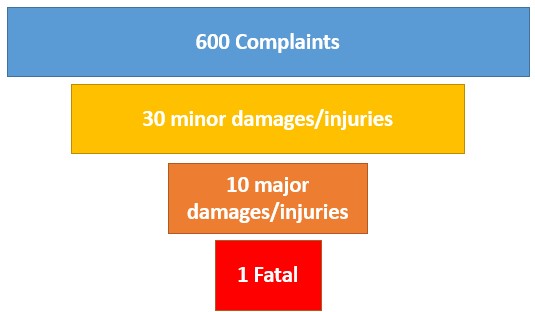National Aerospace Laboratory in Netherlands conducted a study in 2008 that analyzed 2,841 incidents from 14 million flights around the world to find the scope of ground handling accidents and incidents. The research found that of all the reported aircraft incidents, more than 26% happened when the aircraft was on ground.
Furthermore, when these 26% ground incidents are further categorized based on their location, it was found that 84% incidents took place when the aircraft was parked on the aircraft stand i.e., the ramp. It clearly expresses the importance of safety in aircraft ground handling and within ground handling, the importance of safety in ramp operations.
Similarly, Flight Safety Foundation in United States estimates that 27,000 ramp accidents and incidents happen worldwide that equates to one accident per thousand departures. These accidents and incidents injure 243,000 people yearly worldwide.
In view of above, it is necessary that airports have a robust hazard identification and reporting system to maintain a high standard of safety on airside, especially the ramp. This is what today’s article is all about.
Hazard Identification and Reporting System simply refers to development of a proper mechanism for airside workers to identify and report safety hazards wherever observed.
In its most primitive form, a hazard identification and reporting system can be as simple as circulating an email address to all airport departments working on airside where a report may be forwarded for any identified safety hazard on the airside. Behind that email address must be a safety management team that regularly checks the complaints and take actions to resolve them.
In its more sophisticated form, a hazard identification and reporting system can be in the form of an online portal where different airport departments operating on airside could login and report a hazard that the online portal automatically categorizes and processes.
For example, an aircraft ground power unit (GPU) operator may report that he found Foreign Object Debris (FOD) on the ramp comprising broken zips and luggage plastic pieces.
When such an observation would be reported on the hazard identification and reporting system, it would be inferred that whichever agency or company is providing baggage handling services on the ramp is not implementing FOD inspection after the operation is completed.
The team behind the email address we referred to would take up the matter with the concerned ground handling company (or companies if there are more than one) offering baggage handling service. The ground handling company will in turn brief its baggage handling team to observe caution the next time and may even develop a process to prevent baggage handling related FOD from being left on the ramp.
Once the hazard identification and reporting system is properly implemented, it becomes possible to identify trends in complaints by making categories and recording date, time, location and nature of the hazard.
For example, airside can have a particular location where vehicular accidents may be taking place frequently. It may be a turn with an unexpected blind spot for the drivers of Ground Support Equipment (GSE). Such a reporting system has the potential to reveal such a hot spot at the airside.
The airport’s airside management team can then take preventive actions accordingly which, in case of our example, can be as simple as installing a roadside mirror for drivers to see if another vehicle is coming from the other side of the turn.
Airport management can then gauge the progress in airside safety by analyzing whether safety hazard reports are following an increasing trend or decreasing trend year by year.
There is an important catch in hazard identification and reporting systems. Such reporting systems appear to be flooded with complaints that don’t seem critical. It is so because airside workers may report anything and everything that they may seem out of the normal.
However, it is important to understand that such a behavior is normal for such reporting systems and it does not mean that the system is not effective.
As per Airports Council International (ACI) Airside Safety Handbook, out of every 600 reported occurrences of no injury or damage, there are 30 incidents involving minor property damage or minor injuries, 10 accidents involving major property damage or serious injuries and only 1 major or fatal injury.

Therefore, it is normal for a hazard reporting system to have majority of its complaints as non-critical. However, the goal of an airport must be to work its way up to reducing the frequency of accidents and incidents in all levels of criticality.
With trend analysis, categorization and proper monitoring of such a reporting system, it becomes possible to reduce chances of both minor and major incidents on airside (including the ramp).
In this way, a Hazard Identification & Reporting System, once fully implemented in letter and spirit, would remove safety hazards from the airside (including the ramp) by fixing problems time and time again. It in turn gives rise to a safety culture that serves as a backbone for airside safety in general and ramp safety in specific.
If you liked this article, share it with at least one person of common interest. It allows our work to be of service to people who can benefit from it the most.
If you are interested in obtaining a base level knowledge about ramp safety, check out this 7-hour video based course on Udemy that you can easily finish in a week (or binge watch in a day or two). It explains ramp safety in detail with interesting case studies of ramp accidents for in-depth understanding of the subject. It also explains ramp safety aspects associated with 13 main ground handling operations carried out on the ramp.